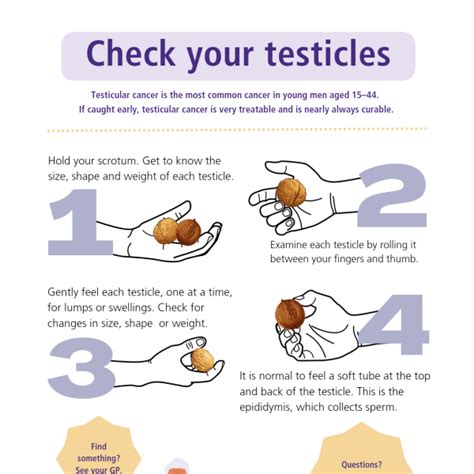How to Check for Testicular Cancer: A Man's Guide to Self-Exams
Testicular cancer is a serious but highly treatable disease when detected early. Regular self-exams are crucial for early detection, significantly improving the chances of successful treatment. This guide will walk you through how to perform a thorough testicular self-exam. Knowing what to look and feel for empowers you to take control of your health.
Understanding Your Testicles
Before we dive into the examination technique, it's important to understand the normal anatomy of your testicles. This will help you distinguish between normal variations and potential abnormalities.
- Location: Your testicles are located within the scrotum, the loose pouch of skin below your penis.
- Size and Shape: Testicles are usually oval-shaped and vary slightly in size, with one often being larger than the other. This is perfectly normal.
- Texture: They should feel firm, smooth, and somewhat rubbery to the touch.
Performing a Testicular Self-Exam (TSE)
The best time to perform a TSE is after a warm shower or bath, when the scrotum is relaxed. This makes the testicles easier to palpate. Here's a step-by-step guide:
Step 1: Stand in Front of a Mirror
Begin by standing in front of a mirror and visually inspecting your scrotum. Look for any swelling, changes in size, or unusual lumps or bumps.
Step 2: Gently Palpate Each Testicle
Using both hands, gently roll each testicle between your thumb and fingers. Feel for any:
- Hard lumps or bumps: This is a key sign of testicular cancer.
- Changes in size or shape: Notice any unusual swelling or shrinkage of either testicle.
- Pain or tenderness: While not always indicative of cancer, persistent pain warrants a visit to your doctor.
- Changes in consistency: Notice any areas that feel harder or softer than usual.
Step 3: Feel for the Epididymis
The epididymis is a soft, tube-like structure located on the back of each testicle. It's normal to feel it, and it shouldn't be confused with a lump.
Step 4: Check for Swelling or Fluid
Gently feel for any swelling or fluid buildup in the scrotum.
Step 5: Repeat Regularly
It's crucial to perform a TSE regularly, ideally once a month. This allows you to become familiar with the normal texture and feel of your testicles, making it easier to detect any changes.
What to Do if You Find Something Unusual
If you detect any lumps, changes in size or shape, pain, or any other unusual findings during your self-exam, don't panic, but do seek medical attention immediately. Early detection significantly improves the chances of successful treatment. Schedule an appointment with your doctor or a urologist for a proper examination.
Why Regular Self-Exams are Crucial
Early detection is key to successful testicular cancer treatment. Regular self-exams allow you to:
- Become familiar with your body: Knowing what's normal for you makes it easier to spot anything unusual.
- Detect abnormalities early: This gives you a better chance of successful treatment if cancer is present.
- Take control of your health: Regular self-exams empower you to be proactive about your health.
This information is for educational purposes only and does not substitute professional medical advice. Always consult with a healthcare provider for any health concerns.
